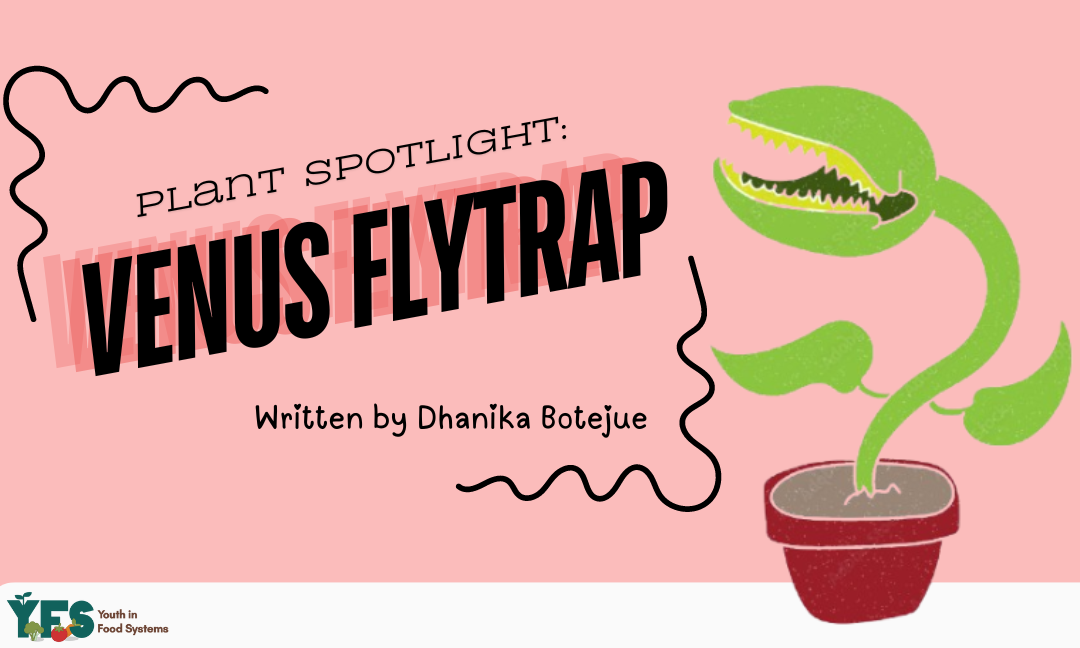Written by: Dhanika Botejue
Edited by: Thomas Luca
Designed by: Eleanor Jeavons
Published by: Rayna Almas
The Venus Flytrap, 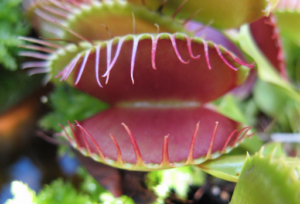 a widely known, spiky green plant with cherry pink insides, loves to digest various carnivorous meals. This leafy plant traps prey using its two hinged lobes at the end of each leaf.
a widely known, spiky green plant with cherry pink insides, loves to digest various carnivorous meals. This leafy plant traps prey using its two hinged lobes at the end of each leaf.
Trichomes, which look like hairy sticking-out bits, can be found on the inner surfaces of the lobes. These structures cause the lobes to close when prey comes in contact with them. This movement process is called thigmonasty, which, in simple terms, is a nondirectional plant response to being touched.
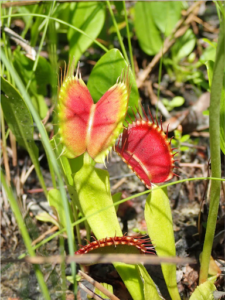 To ensure the plant’s precious energy is used to its maximum potential, the lobes will only shut, creating the “trap” when trichomes are touched several times. “No need to expend energy on a random bit of debris or a raindrop,” said Jeffries, an associate teaching professor in the Department of Forestry and Environmental Resources. The trap is equipped with tiny bristles that interconnect when activated, assuring the creature can’t escape. This unique plant is almost one of its kind: it is one of the few plants to use motion to keep prey trapped.
To ensure the plant’s precious energy is used to its maximum potential, the lobes will only shut, creating the “trap” when trichomes are touched several times. “No need to expend energy on a random bit of debris or a raindrop,” said Jeffries, an associate teaching professor in the Department of Forestry and Environmental Resources. The trap is equipped with tiny bristles that interconnect when activated, assuring the creature can’t escape. This unique plant is almost one of its kind: it is one of the few plants to use motion to keep prey trapped.
Venus Flytraps are only naturally grown within a 75-mile radius around Wilmington, North Carolina. In addition to North Carolina, Venus Flytraps have been cultivated in different states such as Florida and New Jersey. “Venus flytraps live in the wet, open longleaf pine savannas, which need frequent fires to keep the stands open,” said Jeffries. Plants like the Venus Flytrap will not have access to the sunlight they need if there aren’t fires. This danger is a real problem for the population of Venus Flytraps.
Furthermore, habitat destruction is ruining these plants’ futures. North Carolina realized what was happening to the guiltless plant and created laws to ensure the Flytrap would not be poached. This situation became extreme to the point that in October 2016, a petition was launched to enlist the Venus Flytrap as an endangered species.
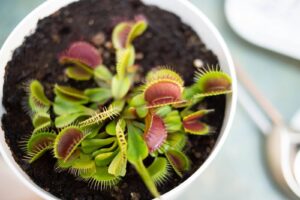
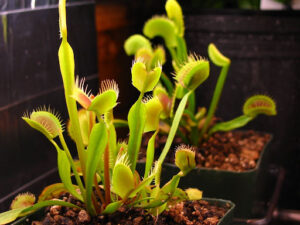
Today, Venus Flytraps are planted in greenhouses to help sustain their lives and futures. The plants need the exact conditioning they would have received in a normal environment. In the same way as Canada’s diverse ecosystems, which can maintain multiple plant and animal species, the Venus Flytraps have adapted and now can thrive in acidic soil. Therefore, people who help support the greenhouses have given these plants acidic soil. Other vital necessities these plants need are humidity and sunlight. For the plants to thrive, they only need to feast on a few small bugs a month. Importantly, the plants need a specific type of deionized water to survive. This is important because tap water contains some minerals that can eventually cause these plants to die. Overall, the Venus Flytraps at these greenhouses are given amazing lives.
How You Can Help
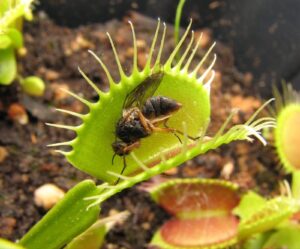 You can help with the Venus Flytrap situation by purchasing a plant or a few seeds. When planting, you must create the same soil they would naturally grow in; wet, acidic, nutrient-poor soil. To do this you could use an acidic moisture-retentive compost. You should feed the plant with dead insects such as flies every two weeks. To feed them, use tweezers and lower the dead insect into one of the traps. The trap will close once the insect has brushed multiple trichomes. Do not dispose of your plant in Autumn, thinking it has died, when, in reality, it is in dormancy. When this happens, you should keep your plant in the coolest room you have in the house, and additionally, you should reduce watering. This change will make the compost drier, but won’t dry it out entirely. Once it is spring, move it back to its original, warmer spot to moisten the compost. A few weeks later, new leaves will have grown in, and you can continue the process as normal.
You can help with the Venus Flytrap situation by purchasing a plant or a few seeds. When planting, you must create the same soil they would naturally grow in; wet, acidic, nutrient-poor soil. To do this you could use an acidic moisture-retentive compost. You should feed the plant with dead insects such as flies every two weeks. To feed them, use tweezers and lower the dead insect into one of the traps. The trap will close once the insect has brushed multiple trichomes. Do not dispose of your plant in Autumn, thinking it has died, when, in reality, it is in dormancy. When this happens, you should keep your plant in the coolest room you have in the house, and additionally, you should reduce watering. This change will make the compost drier, but won’t dry it out entirely. Once it is spring, move it back to its original, warmer spot to moisten the compost. A few weeks later, new leaves will have grown in, and you can continue the process as normal.
Sources:
Venus Flytrap | National Wildlife Federation
Venus flytrap – Dionaea muscipula | Plants | Kew
5 Things You Didn’t Know About Venus Flytraps | College of Natural Resources News
Venus Fly Trap (Dionaea muscipula) | U.S. Fish & Wildlife Service
Venus Flytrap | San Diego Zoo Animals & Plants
How to Care for a Venus Fly Trap | BBC Gardeners World Magazine

